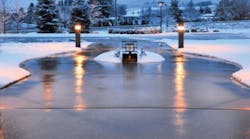Latest from Hydronics & Radiant
Sponsored
By Mike Eby in Orlando
In a conference session at the AHR Expo in Orlando, Fla. on Feb. 3, Kolyn Marshall, Systems Engineering Manager with Watts, reviewed some basic design and installation guidelines associated with snowmelt systems. The presentation offered practical advice for engineers and contractors working with these simple but effective systems.
There are basically two types of snowmelt systems: electric and hydronic. Marshall noted that electric systems are a good fit for areas up to about 1,500 sq ft, whereas hydronic systems are a better option for areas larger in size such as walkways, driveways, patios and parking lots.
A radiant designer basically has four tubing options available to them when designing a hydronic snowmelt system: PEX, PEX-AL, PERT or EPDM. No matter which option is selected, the goal is to minimize the loss of heat from the pipe to the ground. Marshall said there are differing opinions on whether you should insulate the tubing or not. However, he recommends that you insulate around your tubing whenever possible.
Tubing is typically spaced at 6 in., 9 in. or 12 in. Burial depth is directly related to the type of surface your installing the tubing under. Here are some guidelines to follow for three different surface types:
- Slab on grade installations ― when working with a 4 in. to 6 in. slab, tubing must be embedded at least 2 in. below the concrete surface. When working with a deeper slab, Marshall recommends the tubing shouldn’t be installed any deeper than 6 in. from the top of the slab. In other words, install it between 4 in. to 6 in. from the surface;
- Sand base/paver installations ― in this application, you want at least 1 in. of sand above the tubing (after the pavers are vibrated into place) so the pavers don’t rub against the tubing and damage it;
- Asphalt installations ― tubing needs to be installed in the gravel base below the asphalt. Marshall noted that asphalt is half the conductivity of concrete, so system temperature needs to be up in the range of 140˚F to 160˚F for the system to perform as designed;
When it comes to manifold locations, Marshall says your goal is to minimize your tube length. He also says irrigation type boxes are a good option for protecting outdoor manifolds.
Most hydronic system controls and sensors are wi-fi enabled today. This allows the hydronic system to be tied into the local weather forecasting system and configured so it starts up prior to the storm hitting. Marshall said some systems can also be controlled by an app on your phone.
Lastly, always use hydronic anti-freeze in the system. Marshall said most people use propylene glycol today. Then, test the glycol level with a refractometer to ensure the system will deliver proper performance.


